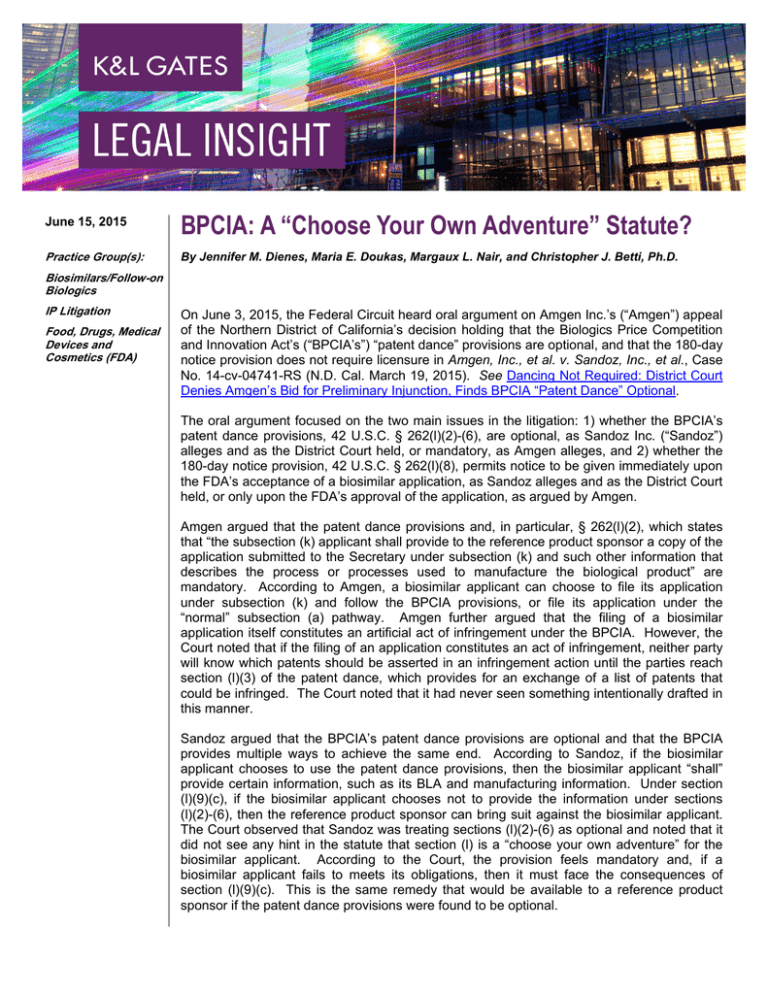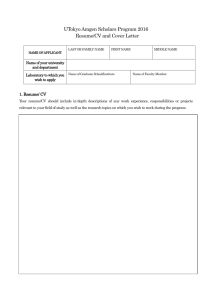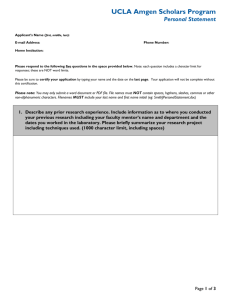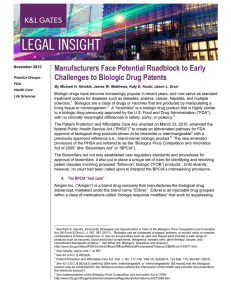
June 15, 2015
BPCIA: A “Choose Your Own Adventure” Statute?
Practice Group(s):
By Jennifer M. Dienes, Maria E. Doukas, Margaux L. Nair, and Christopher J. Betti, Ph.D.
Biosimilars/Follow-on
Biologics
IP Litigation
Food, Drugs, Medical
Devices and
Cosmetics (FDA)
On June 3, 2015, the Federal Circuit heard oral argument on Amgen Inc.’s (“Amgen”) appeal
of the Northern District of California’s decision holding that the Biologics Price Competition
and Innovation Act’s (“BPCIA’s”) “patent dance” provisions are optional, and that the 180-day
notice provision does not require licensure in Amgen, Inc., et al. v. Sandoz, Inc., et al., Case
No. 14-cv-04741-RS (N.D. Cal. March 19, 2015). See Dancing Not Required: District Court
Denies Amgen’s Bid for Preliminary Injunction, Finds BPCIA “Patent Dance” Optional.
The oral argument focused on the two main issues in the litigation: 1) whether the BPCIA’s
patent dance provisions, 42 U.S.C. § 262(l)(2)-(6), are optional, as Sandoz Inc. (“Sandoz”)
alleges and as the District Court held, or mandatory, as Amgen alleges, and 2) whether the
180-day notice provision, 42 U.S.C. § 262(l)(8), permits notice to be given immediately upon
the FDA’s acceptance of a biosimilar application, as Sandoz alleges and as the District Court
held, or only upon the FDA’s approval of the application, as argued by Amgen.
Amgen argued that the patent dance provisions and, in particular, § 262(l)(2), which states
that “the subsection (k) applicant shall provide to the reference product sponsor a copy of the
application submitted to the Secretary under subsection (k) and such other information that
describes the process or processes used to manufacture the biological product” are
mandatory. According to Amgen, a biosimilar applicant can choose to file its application
under subsection (k) and follow the BPCIA provisions, or file its application under the
“normal” subsection (a) pathway. Amgen further argued that the filing of a biosimilar
application itself constitutes an artificial act of infringement under the BPCIA. However, the
Court noted that if the filing of an application constitutes an act of infringement, neither party
will know which patents should be asserted in an infringement action until the parties reach
section (l)(3) of the patent dance, which provides for an exchange of a list of patents that
could be infringed. The Court noted that it had never seen something intentionally drafted in
this manner.
Sandoz argued that the BPCIA’s patent dance provisions are optional and that the BPCIA
provides multiple ways to achieve the same end. According to Sandoz, if the biosimilar
applicant chooses to use the patent dance provisions, then the biosimilar applicant “shall”
provide certain information, such as its BLA and manufacturing information. Under section
(l)(9)(c), if the biosimilar applicant chooses not to provide the information under sections
(l)(2)-(6), then the reference product sponsor can bring suit against the biosimilar applicant.
The Court observed that Sandoz was treating sections (l)(2)-(6) as optional and noted that it
did not see any hint in the statute that section (l) is a “choose your own adventure” for the
biosimilar applicant. According to the Court, the provision feels mandatory and, if a
biosimilar applicant fails to meets its obligations, then it must face the consequences of
section (l)(9)(c). This is the same remedy that would be available to a reference product
sponsor if the patent dance provisions were found to be optional.
BPCIA: A “Choose Your Own Adventure” Statute?
With respect to the 180-day notice of commercial marketing, Amgen argued that section
(l)(8)(a) of the statute requires that a biosimilar applicant give notice of its intent of
commercial marketing after the biosimilar product is licensed. (emphasis added.) Permitting
a biosimilar applicant to provide notice when its application is accepted by the FDA would
reduce a reference product sponsor’s time to contemplate filing a second phase of litigation
to zero. The Court did note that Amgen has already enjoyed a substantial amount of time of
exclusivity, and that most of the patents that could be called into question by Sandoz’s
biosimilar have expired.
Sandoz argued that nothing in (l)(8) states that notice must be given “after” any particular act
or occurrence. The Court, however, noted that providing notice at the time a biosimilar
applicant’s application has been accepted by the FDA is speculative and aspirational at that
point in time because there is no indication at that time whether or when the application will
be approved.
When Amgen was questioned about the remedy it was seeking, Amgen emphasized that it
was not seeking a windfall, but, instead, was requesting that the judgment against Amgen in
the District Court be reversed, the BPCIA be clarified, and the case remanded to the District
Court to fashion an appropriate remedy. Amgen was primarily concerned with ensuring that
it be placed in the position it would have been in had Sandoz complied with BPCIA
requirements.
Sandoz, on the other hand, argued that the preliminary injunction the Federal Circuit entered
against it was moot because there cannot be any factual finding of irreparable harm. The
District Court found there to be no irreparable harm and, according to Sandoz, the BPCIA
only provides that a violation of section (l)(1)(h), a breach of confidentiality, constitutes
irreparable harm.
The Federal Circuit has much to consider when deciding how to rule on these BPCIA
interpretation issues. As the Court noted, the BPCIA could win a Pulitzer Prize for
complexity. It will be interesting to learn whether the BPCIA will be interpreted as a “choose
your own adventure” statute having several optional provisions.
K&L Gates will continue to follow any developments in this litigation.
Authors:
Jennifer M. Dienes
jennifer.dienes@klgates.com
+1.312.807.4219
Maria E. Doukas
maria.doukas@klgates.com
+1.312.807.4223
Christopher J. Betti, Ph.D.
christopher.betti@klgates.com
+1.312.807.4313
Margaux L. Nair
margaux.nair@klgates.com
+1.312.807.4280
2
BPCIA: A “Choose Your Own Adventure” Statute?
Anchorage Austin Beijing Berlin Boston Brisbane Brussels Charleston Charlotte Chicago Dallas Doha Dubai Fort Worth Frankfurt
Harrisburg Hong Kong Houston London Los Angeles Melbourne Miami Milan Moscow Newark New York Orange County Palo Alto Paris
Perth Pittsburgh Portland Raleigh Research Triangle Park San Francisco São Paulo Seattle Seoul Shanghai Singapore Spokane
Sydney Taipei Tokyo Warsaw Washington, D.C. Wilmington
K&L Gates comprises more than 2,000 lawyers globally who practice in fully integrated offices located on five
continents. The firm represents leading multinational corporations, growth and middle-market companies, capital
markets participants and entrepreneurs in every major industry group as well as public sector entities, educational
institutions, philanthropic organizations and individuals. For more information about K&L Gates or its locations,
practices and registrations, visit www.klgates.com.
This publication is for informational purposes and does not contain or convey legal advice. The information herein should not be used or relied upon in
regard to any particular facts or circumstances without first consulting a lawyer.
© 2015 K&L Gates LLP. All Rights Reserved.
3






